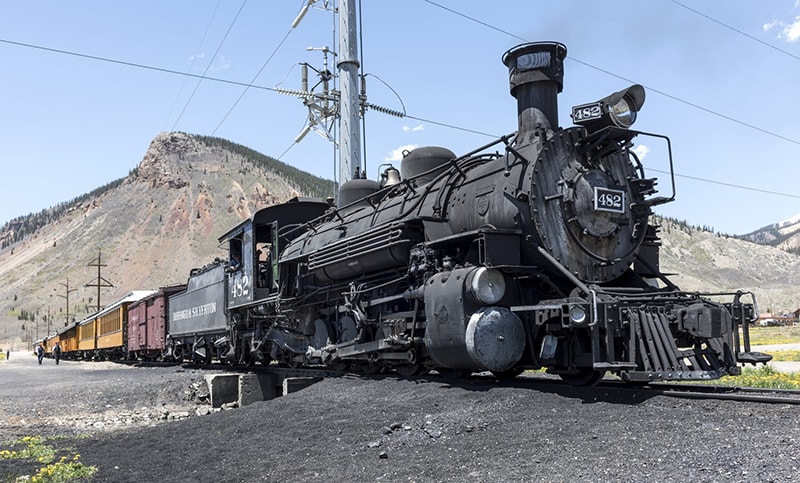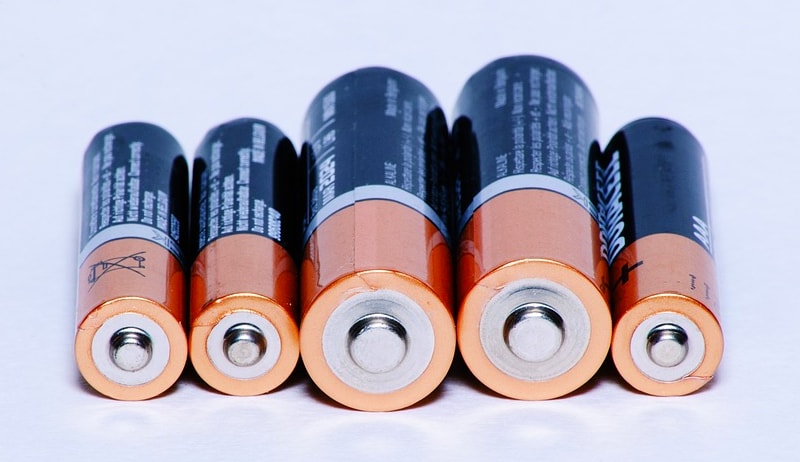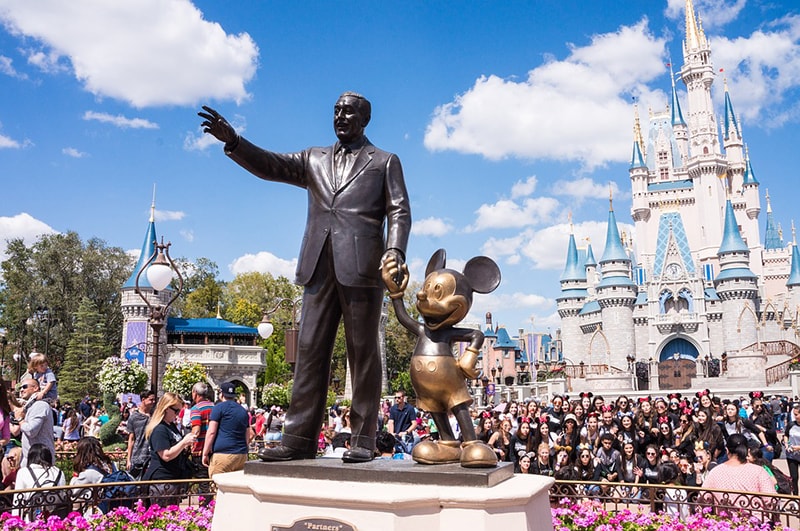Although many scientific discoveries and inventions have been made throughout human history, the clear majority came between the 19th and 20th century. Most inventors listed here lived during that time, which shouldn’t be surprising because those were the days when modern science began to take off and change the world.
That said, it doesn’t mean the previous inventors are less relevant. Inventors came up with brilliant gadgets, equipment, tools, and machines that we still use today, while others opened the doors for future generations to develop and improve. What follows is a collection of 100 famous inventors and their best invention ideas.
1. Cro-Magnon (38,000 BCE)
Before humans, an early generation of people called Cro-Magnon demonstrated outstanding talent in creating tools to help sustain an ancient way of life. Their designs include chisel-like pieces (burin), end-scrapers, nose-scrapers, and retouched blades. These tools were quite sophisticated since they lived around 40,000 years ago. More than that, Cro-Magnon also made carved statuettes, painted scenes, and figurines. Fine bone tools made with retouching techniques, albeit an abrupt ones, were found in ancient caves where they lived as well. They were homo sapiens, suggesting they were our ancestors instead of a different species.
2. Imhotep (2575 – 2130 BCE)
As the chief minister to the second king of Egypt’s third dynasty, Imhotep became associated with Asclepius, the Greek God of Medicine. He was the chief magician to the pharaoh, who most likely also held the position of the nation’s chief physician, according to ancient documents illustrating Egyptian society in the Old Kingdom (2575 – 2130 BCE). Imhotep is considered the architect of the step pyramid in Memphis.
It may not seem like much to us now, but the structure he built is the oldest hewn stone monument in existence. The pyramid has six steps and it stands at an imposing height of 200 feet. If he was alive today, he would probably be the only person to practice medicine while designing buildings.
3. Archimedes
We know more about Archimedes than other ancient scientists because there are a lot of documents describing his life that we can still find today. Many of the stories about Archimedes are anecdotal, but they prove how popular he was (and still is more than 2,000 years after his death). One of his greatest inventions was the Archimedes Screw, which helped people transport water to high ground with as little effort.
He’s also believed to have made two “spheres” that General Marcus Claudius Marcellus brought back to Rome. One of the spheres was a star globe, and the other was a device that represented the motion of planets, the moon, and the Sun. He also discovered a method for measuring gold and silver by using water.
4. Cai Lun
Paper was invented in China, specifically by Cai Lun — a Chinese court official under Emperor Hedi (88 – 105/106). In the year 105, Cai came up with the idea of making sheets of paper from a combination of natural ingredients, including hemp waste, fishnets, old rags, and macerated bark from trees.
Not only did he succeed, but he also found that his invention was superior in writing quality to silk. During that time in China, cloth made of pure silk was the main writing surface. Of course, Cai’s paper became immediately popular because it was more affordable to produce, and the materials were more abundant. Further development of the papermaking process was carried out by his apprentice named, Zuo Bo.

5. Heron of Alexandria
A Greek inventor and geometer, Heron of Alexandria, was considered the most outstanding scientist during the era preceding the Middle Ages period in Europe. The first steam engine was actually his brainchild, just like many other engineering marvels at that time. However, the engine was considered a toy rather than a practical invention. It was called the “aeolipile,” and consisted of a hollow sphere mounted on a pair of hollow tubes connected to a cauldron that provided the steam.
As the steam moved up the tube and entered the sphere, the heat made the sphere move in a rotary motion. The sphere also had one (or more) small hollow tubes for the steam to escape. As simple as it might seem, it was the first practical implementation of transforming steam power into motion.
6. Johannes Guttenberg
The invention of paper allowed humans to make notes and record history without spending too much money on silk, making the process of passing on knowledge to the next generation much more affordable. However, the invention of the printing press completely changed the world. As a matter of fact, many people say that Johannes Guttenberg’s printing press is the most important invention of all time.
One of the unique components of his design was the use of matrices to cast types with excellent accuracy and in large quantities. He also incorporated other available elements, such as oil-based ink, papermaking, bookbinding, and wine-making. He started designing a new printing press in 1439 and managed to use it to print the famous forty-two-line Bible by 1455. More than 200 million books were printed using his printing presses by 1600.
7. Christiaan Huygens
A Dutch astronomer, physicist, and mathematician, Christiaan Huygens were responsible for many important scientific discoveries, including the wave theory of light, discovering the true shape of the ring of Saturn, and uncovering the science of dynamics (action of forces on bodies). His most famous invention was the practical application of the pendulum as a time controller in clocks. His pendulum clock was developed in 1656, and its patent was granted a year later.
Many consider Huygens a greatly-talented mathematician rather than a genius of the first order. Isaac Newton admired him mainly for Huygens’ preference for synthetic methods of experimentation. It’s ironic that much of Huygens’ works on light and dynamics were overshadowed by those of Newtons throughout the 18th century.
8. Antonie van Leeuwenhoek
With a specialization in microscopy, the Dutch scientist Antonie van Leeuwenhoek is credited for discovering microscopic things such as bacteria and blood cells. His observation laid the foundation for modern fields of science, including protozoology and biology. He made his own microscope using a high-quality lens with a short focal length.
At that time, this design was preferable to a compound microscope because the former eliminated the problems with chromatic aberration. Despite the lack of organization commonly present in formal scientific research, Leeuwenhoek’s careful observation led him to important discoveries. Among them was the structure of the flea, along with the entire history of metamorphosis.
9. Benjamin Franklin
Benjamin Franklin was often illustrated as a man flying a kite in a thunderstorm, but this was not an original idea. A similar yet safer technique had been tried in France before. Many of his other discoveries were original, nonetheless. Benjamin Franklin, also one of the Founding Fathers, created a clear distinction between electrical conductors and insulators, invented a battery for storing electric power, demonstrated that electricity was a single fluid with equal amounts of positive and negative charges, and coined many new words such as electrifying, charge, discharge, armature, condense, and conductor.
10. James Watt
In 1764, while repairing the Newcomen steam engine, James Watt was impressed not by the engine itself but by the waste of steam it made. It took him about a year to devise an ingenious solution to improve the engine’s efficiency: a separate condenser. It was his first and greatest invention.
Watt found that the worst defect of the Newcomen engine was the loss of latent heat in the process of creating energy. Therefore, the condensation — which caused the problem — should occur in a separate yet connected cylinder. With the help of John Roebuck and a loan from Joseph Black, James Watt made his own engine in 1768. He was granted the patent for his all-new improved steam engine design, which eventually became the driving force behind the Industrial Revolution a year later.

11. Joseph and Étienne Montgolfier
The Montgolfier brothers were French pioneers who developed and performed the first untethered flights in a hot-air balloon. It all started in 1782 when the two discovered that heated air collected inside a fabric bag caused the bag to move up and fly. While it does sound simple, it took some serious work to figure out how to use it practically.
According to one story, albeit unproven, the brothers came up with the idea when they saw Joseph’s wife’s skirts billow due to the heat generated by a charcoal burner. Finally, they made the first flight in public on June 4, 1783, in which they successfully flew up to 3,000 feet high and remained there for about 10 minutes. They settled to the ground about one and a half miles away from where they took off. The original design was continuously refined and improved, allowing scientists to explore the upper atmosphere.
12. Alessandro Volta
Alessandro Volta came up with the first true battery, a voltaic pile. Volta’s device could store and produce a continuous steady current of electricity and retain most of its power even when not in use over time. Volta started working on static electricity in 1780 and constructed the voltaic pile in 1800. The unit of electromotive force called a volt was derived from his name and coined in 1881.
13. Joseph-Marie Jacquard
The automatic loom, the driving force behind the revolution in the textile industry, was the brainchild of the French inventor Joseph-Marie Jacquard. He worked on the idea in 1790 and demonstrated his improved draw loom in 1801. It did take more than a decade, but only because his progress was cut short by the French Revolution, during which he fought for the Revolutionaries.
Jacquard continued his work and created an attachment to make the loom even better in 1804. After which, any loom that used the attachment was called a Jacquard loom. One notable thing about the Jacquard loom is its programmability. Not only did it revolutionize the textile industry, but it also became one of the earliest versions of a programmable machine. In 1806, the Jacquard loom was declared public property, and the man who invented it was rewarded with royalties and a pension.
14. John Loudon McAdam
In 1815, when John Loudon McAdam held the position of surveyor general of the Bristol roads, he had the perfect opportunity to put his road-building ideas into practice. Instead of utilizing the commonly-used masonry construction approach, he demonstrated that a thin layer of broken stones compacted on a well-drained natural formation could support traffic as long as the thin layer was covered by an impermeable surface of smaller stones. Drainage was crucial to make the design effective, so the pavement must be elevated above the surrounding surface. Many other countries, including the United States, quickly adopted the same method that is still used today.

RELATED: Top 100 Famous Inventions and Greatest Ideas of All Time
15. Nicéphore Niépce
The experiment to produce a permanent photographic image began in 1813 by a French inventor Nicéphore Niépce. Lithography was a popular hobby back in the country, so Niépce took an interest in it, only to discover that he was not skilled enough in drawing. Since he could not obtain lithographic stone locally, he decided to find a method to acquire or provide the images automatically. He started to use pewter covered with various light-sensitive materials to produce superimposed engravings in sunlight.
After three years of trials, he made attempts at photography (Niépce called it heliography or sun drawing). Around 1826/1827, he used a camera to produce a view from his workroom on a pewter plate. In other words, the first photographic image from nature is permanently fixed on a surface. He realized that metal was a better material of choice for etching because of its strength and durability. In 1826, he made another heliograph, which was a reproduction of an engraved portrait. With this heliograph, he solved the problem of reproducing nature by light and invented a photomechanical reproduction method.
16. Robert Fulton
In the late 1780s, Robert Fulton proposed using revolving paddles at the stern of a ship for effective propulsion based on an earlier invention of a mechanical paddle. In addition to that, Fulton also designed a steam warship, submarine, and a system of inland waterways. His journey from being an experimental engineer to a commercially successful person started in 1801 when he met with Robert R. Livingston — the same Livingston who took part in drafting the U.S. Declaration of Independence.
They partnered and shared the expense to build a steamboat in Paris using Fulton’s side paddlewheel design. The boat was about 66 feet long and housed an eight-horsepower engine. It is worth mentioning that Livingston had been in the steamboat navigation business (in fact, he had a 20-year monopoly in that) before he was the minister to France. Thanks to his partnership with Fulton, he continued to reign supreme in the business for quite some time afterward.
17. Eli Whitney
Many people remember Eli Whitney as the inventor of the cotton gin. Still, his most significant contribution to the manufacturing industry was the idea of mass production of interchangeable parts. He was an inventor, manufacturer, and engineer who made a lot of money from the settlement of patent infringement issues regarding his patent on cotton gin.
Their device was all mechanical and consisted of (1) a hopper to feed the cotton into the gin; (2) a cylinder fitted with hundreds of short wire hooks arranged in a way that they matched the grooves; (3) breastwork with a narrow slot too small to allow the passage of cotton seeds; and (4) a bristle to brush the cotton from the hooks. The patent for this device was granted in 1794. Whitney and Miller accumulated around $90,000 for patent rights alone.
18. Alois Senefelder
Nicéphore Niépce probably wouldn’t have moved on to photography if Johann Nepomuk Franz Alois Senefelder of Germany hadn’t kept the method a secret. Senefelder wanted to publish plays he had written but didn’t have enough money to purchase printing plates. So, he did what inventors do: he built one.
It occurred to him that etching the rest of the surface transformed the markings into reliefs. His works on copper plates were unsuccessful, leading him to experiment with limestone. After two years of trial and error, he discovered flat-surface printing. Senefelder did not disclose his method to the public until at least 1818. In later years, he accepted an offer from Johann Anton André to train others about the lithographic process. The king of Bavaria also gave him a good pension.
19. Sir William Congreve
Based on earlier models of rockets used by Hayder Ali (an Indian prince) in 1792 and 1799, Sir William Congreve built a rocket that could reach a target located 2,000 yards away in 1805. The rocket was about 40.5 inches long and fitted a stabilizing stick 16 feet long. Congreve’s invention was used on many different occasions by the British. While he wasn’t the first to make rockets, his invention led to the enthusiastic utilization of black-powder rockets in Europe, especially for military purposes. Another idea of his was reinforcing warships with armor to withstand artillery fire.
20. René Laënnec
The stethoscope was first developed at the Necker Hospital in Paris by René-Théophile-Hyacinthe Laënnec. Appointed as a physician at the hospital in 1816, his original stethoscope was quite rudimentary by today’s standards, yet it helped him improve auditory examinations of the chest cavity. The device was constructed of hollow tubes of wood, and it could only transmit sound to one ear. Despite the basic design, the stethoscope could be easily disassembled and reassembled partly because of the small dimension — it was 10 inches long and 1.4 inches in diameter. Rubber tubing replaced wood at the end of the 19th century.
21. George Stephenson
After George Stephenson of England visited a colliery in 1813, mainly to observe a “steam boiler on wheels” constructed by John Blenkinsop, he figured he could do better. He then built the Blucher, an engine with enough power to haul 30 tons of coal at four miles per hour. Stephenson continued to improve the design and discovered a method to make an efficient locomotive.
The method involved redirecting exhaust steam up the chimney to increase the draft. When the first public railroad transportation became available, the train was pulled by Stephenson’s locomotive called Active (widely known as Locomotion). It ran from Darlington to Stockton at the speed of 15 miles per hour, carrying 450 passengers.
22. Louis Daguerre
The first permanent photograph, along with the method of reproducing images from nature by light, was invented by Nicéphore Niépce of France in 1826/1827. Unfortunately, the exposure time required to produce decent quality images was about eight hours long. Louis-Jacques-Mandé Daguerre, also French, perfected the method by reducing the exposure time to only about 30 minutes. He used a combination of mercury vapor and table salt to expose a plate of iodized silver to make the process more time efficient without sacrificing picture quality. In fact, the picture was better than that produced by Niépce’s method. The image was permanent too.

23. Samuel F.B. Morse
Although the idea of the electric telegraph was invented around 1800, Samuel F.B. Morse believed that his proposal was the first. In 1837, with the help of a friend who provided the materials and labor for developing the proposal, Morse built a model of the telegraph system. A year later, he developed a language system consisting of dots and dashes known today as the Morse code.
Even during Morse’s lifetime, his telegraph was continuously overshadowed by new technologies such as the telephone, radio, and television. The code, however, remains a crucial communication system, especially for military purposes when extremely long-distance communication is necessary. One of the main reasons is that receivers transmit simple tones with better clarity.
24. Charles Babbage
Two things separated Charles Babbage from every other mathematician and engineer in his lifetime: the Difference Engine and the Analytical Engine — both were his projects. While the Difference Engine was the less sophisticated of the two, it could put any calculator available back then to shame. It was a glorified mechanical calculator with the ability to construct a mathematical table, more specifically, logarithm tables for navigational purposes.
The engine could also print results onto a soft metal plate. Between 1985 and 2002, British scientists built the engine that you can see at the Science Museum in London. On the other hand, the Analytical Engine should have been the first computer. It had a mill (CPU), storage to hold data prior to processing (memory), a reader, and a printer. It was a forgotten design until Babbage’s notebooks were published in 1937.
25. Sir Rowland Hill
The postal service we know today has remained mostly the same since Sir Rowland Hill formulated it between 1835 and 1837. To simplify an otherwise complex pricing of postage based on distance and avoid refusal of payment upon delivery, he created a prepaid postage system in which a customer must purchase an adhesive stamp at the post office prior to sending a package or letter. Apart from new pricing due to inflation, it’s still the most reliable postage system used worldwide.
26. Charles Goodyear
As an inventor of an effective rubber tire design and its manufacturing method, Charles Goodyear had an unfortunate life due to patent infringement. Goodyear figured out that a mixture of rubber, sulfur, and white lead could be transformed into an elastic solid that would remain elastic even when exposed to high temperature. The vulcanization process used by Goodyear generally remains the same as it is today.
While his invention made good fortunes for many others (despite patent infringement issues), the inventor didn’t get to enjoy the same luck. In fact, he left a debt of around $200,000 when he died. You can read about his account of the discovery in Gum-Elastic and Its Discoveries.
27. John Deere
In his line of work as an apprentice to a blacksmith in Vermont when he was still in his early 20s, John Deere could tell that wood and a cast-iron plow was ineffective. It occurred to him that the answer was a one-piece share and moldboard made of all-steel material. By 1838, Deere and his partner built and sold a small number of the improved plow. Nine years later, he decided to move to Moline, Illinois and it turned out to be the right decision. Deere and Company are still headquartered in the same city; the company was 105th in Fortune 500 list in 2017.
28. Claude-Étienne Minié
Inspired by the ineffective design of rifle bullets in the 1840s, Minié designed a new model to improve accuracy and lethality upon impact. His bullet design was conical, so it was longer but had more or less the same weight as its rounded counterparts. Despite the same weight, the Minié ball had greater density and retained velocity more effectively.
Another major component was the hollow base which expanded due to the pressure of an exploding charge. As the base expanded when the weapon was fired, the base would engage the rifling to eliminate the long-standing problem of gunpowder residue in a weapon’s barrel. During the U.S. Civil War, the Minié ball was featured prominently and used by both the conflicting parties thanks to its accuracy and efficiency.
29. Louis Braille
Blinded at the age of three in an accident at his father’s harness shop, Louis Braille grew up to be an excellent musician and organist. In 1824, when he was 15 years old, he wrote a music adaptation written with a simple instrument. Instead of writing it down in normal letters, he made a system that consisted of six-dot codes in various configurations to represent letters in the alphabet. In other words, a written language system for the blind.
He introduced the system in a treatise in 1829 but the adoption was quite slow, and Braille never saw his idea officially adopted for educational purposes. Schools in Paris did not officially use the system until 1854 — two years after his death. A universal code for English-speaking Braille was approved in 1932.
30. Cyrus McCormick
During the early 19th century, harvesting crop was not always a pleasant time for farmers in the United States. Harvesting required a lot of labor, and the cost to hire them would be far from being affordable. In 1831, a young inventor named Cyrus Hall McCormick from Virginia built a mechanical reaper consisting of a vibrating cutting blade, a reel, and a platform to receive the falling grain. Also resembling a two-wheeled chariot, the equipment introduced the working principles of modern grain-cutting machines. It was an award-winning invention and by 1855, the reaper became known to farmers all around the world.

32. Elisha Graves Otis
When working as a master mechanic in a bedstead factory in 1852, Elisha Graves Otis was sent to New York to install a device called a safety hoist in a new factory. He designed an elevator equipped with a clamping mechanism that would grip the guide rails on which the car moved in case the rope lost its tension.
Although this wasn’t the first elevator, it surely is the first to use an automatic safety device to prevent it from free-falling in the event of a broken chain or rope. He called it a safety hoist. In the following years, Otis improved his design and installed the first elevator for passenger use powered by steam in 1857. He also patented a steam plow in 1857 and a bake oven a year later.
32. Sir Henry Bessemer
During the Crimean War, Bessemer realized that blowing air through melted cast-iron could introduce more heat to the material and further purify it at the same time. The method also made the pouring process of purified iron much easier. The air could generate heat due to the chemical reactions from oxygen in the air with silicon and carbon in the iron. Later on, the technique became known as the Bessemer process.
He devised all sorts of equipment to make the process more effective including larger ingots and a tilting converter. One of the major problems was that the iron could contain dangerous levels of phosphorous substances. Robert Forester Mushet, an English metallurgist, came up with a process to remove such impurities by burning them off as much as possible, then introducing carbon and manganese at the next manufacturing step with the right amount of spiegeleisen. Bessemer purchased the patent for it too. He was now capable of producing mild steel with better malleability to withstand more rolling and forging.
33. Samuel Colt
Before Samuel Colt introduced his firearm design, revolvers required the shooter to line up a bullet chamber with the barrel, cock the hammer, and then pull the trigger. While the mechanism was quite familiar, the shooter had to do each in a separate step. Colt’s design simply required the shooter to cock the hammer with a thumb before the weapon could send a bullet. The cocking action was linked to the bullet chambers, so they automatically rotated.
He patented the design in France and England in 1835 and in the United States a year later. Until his U.S. patent expired in 1857, he had dominated the revolver market in the country. During the Civil War, Colt’s revolver was the most widely used pistol.
34. Richard J. Gatling
As you have probably guessed by the name, Richard J. Gatling is best known as the man who brought the Gatling gun to existence. This was the earliest model of a machine gun. Instead of firing the bullets automatically, however, the gun was crank-operated. It consisted of 10 barrels, each of which was mechanically loaded and fired one time as the crank completed one full rotation. A cartridge container was mounted directly above the actual gun; therefore, gravity had the reloading process covered.
The first-half of crank rotation loaded and fired the gun, and the second-half was when the mechanism ejected the spent cases. Gatling patented his invention in 1862. By the time the authorities approved official adoption of the gun, however, the civil war had practically ended.
35. James Starley
Also known as the “Father of the Cycle Trade” for his prolific improvements for both tricycles and bicycles, James Starley introduced a lot of innovations to the basic design of the vehicle (many of which are still used today). Among them were the use of solid rubber tires and wire-spoked wheels to smoothen the ride.
Prior to Starley’s innovations, bicycles used wooden wheels and were very uncomfortable to ride. They were so rough that people called them the boneshaker. In addition, Starley also invented the center-pivot steering design that he used in his second bike called the Ariel (1871), featuring a 48-inch front wheel and three-inch rear wheel. Many historians consider it the first true bicycle. Ariel became the standard bicycle design for the next decade too. In 1876, Starley built the Coventry tricycle and incorporated the patented use of a chain drive and differential gear. It was a highly successful model.

36. Alfred Nobel
Primarily recognized as the founder of the Noble Prizes, Alfred Bernhard Nobel had two other notable inventions: the explosive detonation of nitroglycerin and dynamite. During the late 1850s, black powder was the most potent and safe explosive used in mines. Nitroglycerin was known about then, but it was so powerful that nobody knew how to detonate it from a safe distance.
In 1863, Nobel invented a practical detonation method by using a wooden stick inserted into a metal container filled with a large charge of nitroglycerin. The stick had a small charge of black powder intended to start a chain reaction that would eventually explode the entire container. Just four years later, Nobel figured out a method to contain nitroglycerin in a more stable state. When exposed to a material known as kieselguhr (a siliceous sedimentary rock), nitroglycerin was absorbed, and the resulting mixture became safer to handle. He was granted a patent in 1868 (United States) and 1868 (Great Britain).
RELATED: Check out this list of 47 Eco-Friendly Product Designs!
37. John Wesley Hyatt
The first practical form of artificial plastic was celluloid, of which John Wesley Hyatt discovered the manufacturing process. He was interested when a billiards company based in New York offered a $10,000 reward for anybody who could invent a material satisfactory enough to substitute ivory to make billiard balls. While he did not manage to get the reward, he and his brother Isiah continued experimenting and found the right combination of substances to make a very versatile material called celluloid.
Hyatt used a mixture of nitrocellulose, camphor, and alcohol and then pressed it in a heated mold. Both transparent and opaque colors could be added later in the process when the material was kneaded.
38. Ferdinand Von Zeppelin
While the hot air balloon had already been a popular means of air transportation even before Zeppelin was born, it did not stop him from making it even better. The long-standing problem of the typical hot air balloon was the difficulty of maintaining its shape for an extended period during a flight. As soon as the gas bag changed shape, the balloon became much harder to steer. Zeppelin understood that maintaining the shape would improve handling and overall maneuverability.
In 1908, he was ready to fly with the LZ-4, a 446 feet long airship carrying hydrogen. It was rigid and dirigible, allowing for a sustained flight of 12 hours at 45 miles per hour over Switzerland. Even today, the term Zeppelin remains synonymous with an airship.
39. Georges Leclanche
The electric battery was a subject of continuous improvement. Benjamin Franklin is credited as the inventor, or at least the man from which the idea originated, and Alessandro Volta made the first true battery. In 1866, Georges Leclanche made another improvement using a combination of ammonium chloride (the electrolyte), zinc (negative terminal), and manganese dioxide (positive terminal). The original version of Leclanche’s battery was wet, but then an immobilized electrolyte was introduced in the 1880s, hence the dry cell, which remains widely popular today. The Leclanche cell is still available and actually one of the most affordable in the world.

40. Hiram Maxim
The first patent that Hiram Stevens Maxim obtained was for a hair-curling iron in 1866. However, he earned considerable prominence in 1884 when he developed the first efficient fully-automatic gun. Maxim took advantage of the recoil energy generated by the bullet to unlock the breechblock, eject, and extract fired cases from the gun.
Moreover, sufficient energy would be left in the mainspring for reloading. If the trigger were continuously pulled, the gun would fire until it ran out of ammunition. To avoid overheating, a metal jacket filled with circulating water surrounded the barrel, making the gun heavier and more complex.
41. Alexander Graham Bell
Apart from three years of formal education and a few lectures at University College in London and Edinburgh, Alexander Graham Bell was self-taught. Not particularly a dexterous man, Bell was fortunate to come across a young mechanic, Thomas Watson, who assisted him in devising an electrical apparatus for transmitting sounds through electricity. Bell was granted patents for many of his telegraphs in April 1875, but it would take many more months until he obtained his most crucial patent of them all, the telephone. Since March 7, 1876, Bell has been officially acknowledged as the inventor of the telephone.
42. John Philip Holland
The idea of using submersible vehicles for military purposes started during the siege of Syracuse around 415 B.C.E. It would take many centuries until the United States Navy accepted its first underwater vessel proposed by John Philip Holland. Educated at Limerick and immigrated to the United States from Ireland in 1872, Holland built his first small submarine called the Fenian Ram in 1879; this project was carried out under the directives of the Irish Fenian Society, who hoped to use the vehicle against Britain.
In 1895, his company (the J.P. Holland Torpedo Boat Company) received an official contract to build a submarine for the U.S. Navy. The submarine was called the Plunger, powered by electricity when submerged and steam when on the surface. After many design changes and improvements, the project was eventually abandoned, and he returned the funds accepted earlier. He continued building more submarines at his own expense and made a breakthrough with the Holland VI in 1897, the first modern submarine acquired by the U.S. Navy in 1900.
43. Karl Benz and Gottlieb Daimler
Both are regarded by most motoring authorities around the world as the most important pioneers in the automobile history. In 1885, Karl Benz drove his first car, a three-wheeler, one-cylinder engine vehicle designed to run at 250rpm. He patented it about a year later, on January 29, 1886. Around the same time, Gottlieb Daimler successfully built a four-wheel car, although it was a modified horse-drawn carriage fitted with a one-cylinder engine. Eventually, both men’s firms merged in 1926, and the subsequent models from the company have been called Mercedes-Benz until now. Oddly enough, Benz and Daimler never actually met.

44. Thomas Alva Edison
With 1,093 U.S. patents registered under his name, Thomas Alva Edison was possibly the most serious inventor and businessman ever. Starting his career in the telegraph industry in 1863, he contributed to modernizing electricity and its applications throughout his life.
Before he died in 1931, Edison successfully made many great ideas into reality. One of the most notable was the incandescent lamp, but there were many others. For example, an electricity generator of unprecedented efficiency, an electric railroad, a commercial power system, and a phonograph. In addition to all of those, Edison was the first to build a research laboratory at the industrial level.
45. Wilhelm Conrad Röntgen
While experimenting with a cathode-ray tube in 1895, Wilhelm Conrad Röntgen discovered a phenomenon he and nobody else had seen before. When the tube was active or operated, he saw that a nearby barium platinocyanide also produced light. Further experimentations revealed that such radiation penetrated through many different materials, such as paper, aluminum, and wood. Despite his persistent curiosity, he could not figure out the mechanism, hence X-radiation. One of the first X-ray images was the bones in his wife’s hands.
46. Otto Lilienthal
During the years leading up to the Wright Brother’s debut flight, Otto Lilienthal was the most crucial German pioneer in the aeronautical world. He figured that wings, like birds, should be crucial elements of a vehicle designed to maneuver in the air. Between 1891 and 1896, Lilienthal made around 2,000 successful flights in at least 16 different glider models. Most of the flights were completed in his standard model: a glider with a fixed-wing (which looked like a bird’s wing) and a stabilizing tail. On August 1986, Lilienthal had a glider accident in which he broke his back; he died the next day in Berlin Hospital.
47. Emil Berliner
Just a year after Alexander Graham Bell obtained the patent for the telephone, Emil Berliner developed an apparatus that was supposed to be a transmitter for a telephone. It was a simple device with metal contact separated by a carbon layer. While it didn’t work as effectively as he wanted, the Bell Telephone Company purchased the rights to the invention anyway. Berliner became known as the inventor of a carbon microphone afterward. His greatest invention emerged in 1887 when Berliner devised a flat recording disc on which a spiral recording groove was more effectively inscribed using a stylus that moved laterally. The sound quality was good, and the disc’s manufacturing process was also more efficient. Berliner called it a gramophone.
48. Nikola Tesla
Most of today’s alternating current machines are still based on the rotating magnetic field discovered and patented by Nikola Tesla. He was born in Austria-Hungary (now Croatia) in 1856 and immigrated to the United States in 1884. Just a year after his arrival, he sold the patent rights to his system of alternating-current motors, dynamo, and transformers to George Westinghouse.
According to Tesla, his most important discovery occurred in the early 1900s with the discovery of terrestrial stationary waves. In other words, the Earth could be used as an electric conductor, so wires were not necessary to power street lamps. A year before that, Tesla demonstrated the working principle of remote control using a toy boat in front of a crowd in Madison Square Garden.
49. Rudolf Diesel
Besides his interests in art and language, Rudolf Christian Karl Diesel of Germany was also a thermal engineer. He devoted much of his time to developing a new version of an internal-combustion engine. After receiving a German development patent for his idea in 1982, he published the Theorie und Konstruktion eines rationellen Wäremotors (Theory and Construction of a Rational Heat Motor), in which he provided a description of his engine. He continued building successful models afterward, eventually leading to a significant breakthrough with a 25-horsepower four-stroke single-cylinder engine. It was called the diesel engine and an immediate commercial success, earning him royalty fees of a significant amount.
50. George Washington Carver
Receiving a bachelor’s degree in agricultural science in 1894 and a Master’s of Science in 1896 from Iowa State Agricultural College, Carver left for Alabama to claim the position of director of agricultural research at the Tuskegee Normal and Industrial Institute in Alabama. Carver developed numerous derivative products in his research projects with the institute. He created 300 derivative products from peanuts, including milk, cheese, coffee, cosmetics, oils, soap, plastics, ink, and dyes. There were also 118 products from sweet potatoes, such as glue, flour, vinegar, and even synthetic rubber. In 1914, when boll weevils nearly delivered total destruction of the agricultural industry of the South, Carver revealed his ideas to the public and revolutionized the economy in the region. What had been exhausted lands became major suppliers of many agricultural products.
51. James A. Naismith
In the autumn of 1881, James Naismith was appointed an instructor at the Physical Education Department at Springfield University (Massachusetts). He was assigned to find a new game to replace an existing boring and rather dangerous winter indoor game. Taking his cues from field hockey, American football, and soccer, Naismith developed a new game called basketball. Each of the two teams in the original game consisted of nine players, and the goals were modified half-bushel peach baskets. William R. Chase made the first and only score.

52. Auguste and Louis Lumière
A film titled La Sortie des ouvriers de l’Usine Lumière (Workers Leaving the Lumiere Factory), recorded in 1895 is considered the first motion picture ever. It was recorded by Auguste and Louis Lumière using an apparatus called a Cinematographe they devised themselves. The apparatus consisted of a single camera capable of photographing and projecting them at 16 frames per second. A demonstration at the Grand Café in Paris brought them to fame and started the cinema history. They recorded more than 40 films in 1986; most of them told the stories of everyday life in the country.
53. Henry Ford
In addition to his groundbreaking design in the automobile industry, Henry Ford’s greatest innovation was the assembly line based on the production line Swift and Company Meat Packing House in Chicago, Illinois. After much consideration, the assembly line was implemented in Ford’s new plant in Highland Park, Michigan, in 1913–1914. The system effectively reduced production time and increased manufacturing capacity to a great extent. A complete Ford Model T chassis with the assembly line was completed within 93 minutes, significantly improving from the previously recorded 728 minutes.
54. Reginald Fessenden
During an experiment in wireless telegraphy for the U.S. Weather Bureau in 1900, Reginald Fessenden came up with the idea of superimposing electric waves and vibrating them at the frequency of sound waves. He tried to modulate radio waves into the shape of a sound wave, hence amplitude modulation. It worked, and he became the first to broadcast a radio program (voice and music) over long distances.
55. Wilbur and Orville Wright
The basic principle of winged flight was suggested by Otto Lilienthal of Germany while internal combustion engines were becoming lighter as well. The Wright Brothers figured that the lift and propulsion issues in a flight should not be the main concerns in their experiments. The more pertinent problem was controlling flight.
Instead of maneuvering by turning just like steering a bicycle, Wilbur and Orville devised a mechanism to lift or lower each wing tip of their airplane to change direction. By October 1905 and after many attempts, they made a successful flight for around 39 minutes. It was not just a flight, but one sprinkled with circle turns and other maneuvers. They had kept the design secret for three years until 1908 when they received a contract to build a plane for the U.S. Army for $25,000.

56. Lee De Forest
Live broadcasting was made possible thanks to a vacuum tube called the Audion, invented by Lee De Forest in 1907. Since the Audion was more effective at receiving wireless signals than the available alternatives, it became essential in all radios, televisions, and telephones. De Forest sold his patent to the American Telephone and Telegraph Company, which used Audion as an amplification component for long-distance receivers.
57. Guglielmo Marconi
In 1894, an Italian physicist Guglielmo Marconi made a successful experimental shortwave signal transmission over a long distance. After some initial attempts of short distance transmission, he improved the receiver range by using a vertical pole attached to a metal plate at the top and on the ground. He also figured that a concentration of radiated electrical energy delivered better quality than a dispersed one.
Twenty years after this initial test in Italy, Marconi continued his work in Great Britain on short wavelengths. In 1923, he received a signal transmitted from Cornwall on a steam yacht 1,400 miles away. His experiments, especially on short wavelengths, set the development of most modern long-distance wireless communication.
58. Robert Hutchings Goddard
In his small Clark University laboratory, Robert Hutchings Goddard proved that thrust and propulsion could occur somewhere without air to push against or in a vacuum. Goddard became the first to launch a rocket exceeding the speed of sound in 1935. He also obtained the first patent for the step rocket, which allowed the apparatus to reach even higher altitudes. He invented many components, such as rocket fuel pumps and engine cooling mechanisms, specifically designed to send humans to outer space.
59. Clarence Birdseye
Frozen foods have changed the face of food manufacturing, processing, and distribution. It was Clarence Birdseye who developed the method to achieve low-enough temperatures to keep many foods fresh over an extended period of time. He had two methods: the first involved placing food between two metal plates pre-chilled using calcium chloride solution at a temperature of -40°C; the second method was quite similar, but the cooling process used ammonia vaporization to reach -25°C temperature.
60. Igor Sikorsky
In 1910, Sikorsky built a (somewhat) successful helicopter model propelled by a 15-horsepower engine. He called the vehicle the S-1. More models soon followed, including the S-2, S-3, and S-4, with minor improvements. In 1911, using the S-5 equipped with 50 horsepower, he could fly for more than 60 minutes and reach an altitude of 1,500 feet. He even made cross-country flights with a helicopter. These flights earned him an International Pilot’s License.
61. Vladimir Zworykin
After receiving funds for his research project from R.C.A. (Radio Corporation of America) in 1929, Vladimir Zworykin started working on his idea of a cathode-ray receiver, which he named a kinescope. As it turned out, the kinescope began the development of modern television. While the kinescope was replaced by image orthicon tubes, Zworykin’s idea was the basis for television camera design. Another notable innovation of Zworykin was the color-television system, for which he was granted a patent in 1928.
62. Edwin H. Armstrong
While working on the persistent problem of static in radio transmission, Edwin H. Armstrong devised an entirely new radio system to eliminate it. Rather than varying the amplitude of radio waves — as in all radios at that time — his new system modulated the number of waves per second over a wide range of frequencies. This created a carrier wave that static could not break into. Frequency modulation, as it is now called, opened the door for clear practical high-fidelity broadcasting. In 1939, Armstrong built an F.M. station, which cost him more than $300,000 to prove the innovation’s value.

63. Richard Buckminster Fuller
A recipient of the Royal Gold Medal for Architecture and the 1968 Gold Medal Award of the National Institute of Arts and Letters, Richard Fuller’s greatest idea was the geodesic dome design based on a system of geometry he called Energetic-Synergetic. The basic shapes of his dome consisted of a pyramid (with four sides including the base) and an octahedron to build the most budget-efficient yet space-filling structure. Fuller was interested in the idea for two reasons: a dome is strong for its weight and covers the least surface area while enclosing the largest volume.
64. Paul Müller
Thanks to Müller’s discovery of the potent toxic effects of dichlorodiphenyltrichloroethane (commonly referred to as D.D.T.), the world could sustain its food production capacity and suppress many insect-borne diseases. The U.S. Department of Agriculture successfully tested D.D.T. in 1939 against the Colorado potato beetle. Paul Herman Muller received a Nobel Prize in Physiology or Medicine for the discovery.
65. Ernest O. Lawrence
For his invention of the cyclotron, the first particle accelerator to generate high energy, Ernest O. Lawrence received a Noble Prize in Physics in 1939. He began his work on the accelerator in 1929, but it was actually one of his students named M. Stanley Livingston undertook the project and finally built a device with the capability of accelerating protons to 13,000 electron volts (eV). Lawrence had more direct involvement during the second cyclotron project; when completed, the device accelerated protons to 1,200,000 eV — more than enough to cause nuclear degeneration.
66. Charles Stark Draper
When the world began to truly realize the potential destructive power of military aircraft at the beginning of World War II, Charles Stark Draper devoted his time to developing an anti-aircraft weapon system. An aircraft was too agile and fast for any traditional weapon to take down. With support from M.I.T. and the Sperry Gyroscope Company, Draper and his students developed the Mark 14 lead-computing anti-aircraft weapon with the ability to calculate an airplane’s position by taking distance, wind, and gravity into account. His laboratory at M.I.T. was a center for the design of guidance and navigational systems for missiles, aircraft, and ships from World War II through the Cold War.
67. Walt Disney
Animated films had already existed before Walt Elias Disney realized that he could blend animation with sound into a single motion picture. One of Disney’s major breakthroughs in the industry happened in 1928 when he released the third Mickey Mouse cartoon Steamboat Willie featuring music and voice. It was an instant sensation and set the course of Disney’s future.

68. William P. Lear
Several years before World War II broke out, a self-taught American, William Lear, developed a universal radio amplifier. As the name suggests, the device was compatible with any radio available. By 1939, more than half of private airplanes in the United States were fitted with Lear’s radio equipment. He earned much money from the invention and used his wealth to form Learjet, Inc. in Wichita, Kansas. The company remains one of the most popular private jet makers worldwide.
69. Felix Wankel
Despite lacking a formal engineering degree, Felix Wankel of Germany was hired by major car companies, including Daimler-Benz and BMW, at various times. In 1951, he worked in the research department at N.S.U. Motorenwerk AG, located in Lindau, Germany, where he designed and completed his first rotary engine. Ten years later, a Japanese automobile company, Mazda, began using Wankel’s engine in some models. Wankel later established his own laboratory in Lindau and continued improving his design.
70. John Von Neumann
Along with Claude Shannon and Alan Turing, Neumann played a major role in developing early programmable digital computers. He was a prominent mathematician in his early 20s and, throughout his life, made great contributions to the U.S. nuclear defense strategy. In his final years, Neumann outlined a new machine design that could replicate itself. The machine would read its own design as a set of instructions and copy the design to build another new machine. Later discoveries in genetics were at least conceptually based on this idea.
71. Chester F. Carlson
Beginning in 1934, Carlson worked on a new way to quickly and conveniently copy texts and drawings. Instead of focusing on chemical-based processes, like many large corporations back then, he determined that electrostatics could deliver a better solution. Carlson figured that exposure to light could increase the conductivity of certain substances. When the light was removed, the electric current could be eliminated too. He called this a xerography and made the first successful attempt in 1938. A small firm based in Rochester, the Haloid Company, obtained the commercial rights to the invention and introduced the first office copier 11 years later. Royalties made Carlson a multimillionaire.
72. Grace Murray Hopper
The UNIVAC I — the first commercial computer — and naval applications for COBOL (common-business-oriented-language) are just a few examples of computer technologies that Grace Murray Hopper played significant roles in developing and implementing. She worked on Mark I- the first large-scale automatic calculator when assigned to the Bureau of Ordnance’s Computation Project at Harvard in 1944. She also coined the term “bug” to describe unexplained computer failure after a moth infiltrated the circuit of the calculator.
73. Frank Whittle
The Air Ministry ridiculed his senior thesis at the R.A.F. College on jet propulsion in 1928 as impractical, but it didn’t stop him from continuing development. He obtained his first patent for a turbo-jet engine just two years later and founded Power Jets, Ltd. with his associates in 1936. However, the actual operational jet-powered aircraft was built and tested successfully for the first time in Germany by Hans Pabst von Ohain on August 27, 1939.
74. John Mauchly and J. Presper Eckert
With government funding during World War II, Mauchly and Eckert began working on an all-electronic computer called the ENIAC (Electronic Numerical Integrator and Computer) in 1943. John von Neumann, who at that time was still working on the Manhattan Project, also contributed to the development of ENIAC. They pulled it off in 1946; ENIAC was the most powerful calculator and the first programmable all-purpose electronic digital computer.
75. Edward Teller
Known as the father of the H-bomb in the United States, Edward Teller and Stanislaw Marcin Ulam developed the basis of the weapon. A bomb built using the Teller-Ulam configuration was successfully tested in 1952 at Enewetak Atoll, yielding an explosion with the power equivalent of 10 megatons of T.N.T. Edward Teller became associated with the development of the first thermonuclear weapon.

76. Michael DeBakey’s
Regarding cardiovascular surgical procedures, very few people surpassed Michael DeBakey’s achievements. One of his first inventions came about in 1932, the roller pump, a component of a heart-lung apparatus that made open-heart surgery possible. The first successful carotid endarterectomy procedure happened in 1953 by DeBakey. The first coronary artery bypass took place in 1964, also by DeBakey. The first successful implantation of a V.A.D. (ventricular assist device) occurred in 1966 by none other than DeBakey.
77. Willard Libby
In addition to inventing the method to separate uranium isotopes during his tenure at the Manhattan Project, Willard Libby was also the chemist to settle the debate as to whether the Shroud of Turin covered the body of Jesus. Although he was not directly involved in the experiment, his radiocarbon-dating method proved that the shroud appeared between 1260 and 1390. Carbon-14 (radiocarbon dating method) earned Libby a Nobel Prize in Chemistry.
78. Edwin Herbert Land
Based on the polarizing principle he discovered in 1932, Edwin Herbert Land began working on non-military applications of his Polaroid J sheet after World War II. Two years of experimentation led him to invent the instant camera with the ability to capture a photograph and finish printing it in just 60 seconds. The Polaroid Land Camera and every improved model afterward are still among today’s most popular photography equipment.
79. Virginia Apgar
Her most prominent idea was developing a medical approach to evaluate an infant immediately after birth to determine whether the newborn required medical intervention to improve chances of life. Today, the Apgar Score System is still widely used worldwide. She made the first demonstration of the evaluation in 1952 based on five relatively simple observations on the infant’s pulse rate, skin, activity, reflex irritability, and respiratory effort; all could be carried out within one minute after birth.
80. Leo Fender
In 1948, Leo Fender and George Fullerton developed the first mass-produced solid-body electric guitar. It was named the Fender Broadcaster (renamed the Telecaster two years later). While this is not the first electric guitar, it was the first commercially successful one. A more stylish version called the Stratocaster became available in 1954. Equipped with three (instead of two) electric pickups, the Stratocaster produced sharp clean sound praised by the world’s best guitarists, including Jimi Hendrix, Pete Townsend, John Lennon, and David Gilmour.

81. William Shockley, John Bardeen, and Walter Brattain
Working together at Bell Labs, the three invented the first practical effective semiconductor amplifier on December 16, 1947. The electric component was called the point-contact transistor. It had two closely spaced wires connected to the surface of germanium. One wire received the input signal and increased the conductivity of the germanium, and the other wire modulated the output signal.
82. Wernher Von Braun
The director of NASA’s George C. Marshall Space Flight Center in Huntsville (July 1, 1960, to January 27, 1970), Wernher Von Braun played a major role in the development of space vehicles, including Saturn I, I.B., and V. Each of those space boosters contained millions of parts so complex that the level of sophistication and the degree of success are still unmatched. Every launch met safety requirements and was completed on time.
83. Charles Townes
After the successful invention of the maser (microwave amplification by stimulated emission of radiation) in December 1953, Charles Townes, with the help of Arthur L. Schawlow of Bell Labs, experimented with the optical application of the maser — the laser. He also shared his idea with Gordon Gould, a graduate student at Columbia University. Townes and Schawlow published their “optical maser” idea in the December 1958 issue of Physical Review; around the same time, Gould coined the term “laser” and filed a patent for it. Years of intense debate and litigation eventually went Gould’s way. He obtained several patents starting in 1977 and earned millions from royalties.
84. Gertrude B. Elion
In 1944, Gertrude Elion joined the Burroughs Welcome Laboratories and met with George H. Hitchings. They worked together for the next 40 years, developing several drugs that effectively treated various diseases, including autoimmune disorders, gout, urinary tract infection, viral herpes, malaria, and leukemia. Instead of using trial-and-error, they eliminated the guesswork by first examining the difference between normal and cancer cells as well as viruses, bacteria, and pathogens. Based on the findings from the examination, they formulated drugs to inhibit the development of pathogens without damaging normal cells.

85. Frederick Sanger
One of the only four people to receive the Nobel prize twice, Frederick Sanger earned what was deserved from his work on the structure of the protein (especially that of insulin) and the determination of the nucleic acid base sequence. His works on insulin became the first significant step in producing synthetic human insulin. Since then, it has led to advances in diabetes treatments.
86. Tom Kilburn
One of Kilburn’s most ambitious projects was the MUSE (starting in 1956 and renamed the Atlas three years later), aimed at developing a computer that can do multiple programs simultaneously. The project was completed in 1962 with an impressive result: the Atlas was the first computer to utilize a slower external memory as if the component was simply an extension to the much faster computer’s internal memory. Today, the mechanism is known as virtual storage or virtual memory and is used in every modern computer unit.
87. Stephanie Kwolek
During his tenure at DuPont, Stephanie Kwolek began working on a type of polymer called aramids in the 1950s to 1960s. Her experimentations led to the release of Nomex (a brand name of poly-m-phenylene isophthalamide) in 1961. She continued working on another project involving two more materials: poly-p-benzamide and poly-p-phenylene terephthalamide. The resulting fibers from those materials were stiff like nothing before, with excellent tensile strength. The product was released commercially as Kevlar.
88. Douglas Englebart
Starting in 1963 with funding provided by the S.R.I. (Stanford Research Institute), Englebart and William English — a colleague from S.R.I. — worked on and perfected various computer input devices, including joysticks, trackballs, and light pens. Before Englebart’s inventions, computers were only valuable to a handful of people who knew how to set electronic switches on keypunch cards. You could say that Englebart helped everyone operate a computer with ease.
89. Robert Noyce
After spending time at the Fairchild Semiconductor Corporation during the late 1950s, Robert Noyce and Gordon Moore left and started their own company in 1968. Also joined by former Fairchild employee Andrew Groove, the three founded Intel Corporation. It took them two years to build the first microprocessor with circuitry for information storage, and processing arranged on a silicon chip. Intel remains a leading microprocessor manufacturer today.
90. Ron Toomer
The Runaway Mine Ride, the first all-steel coaster constructed in 1966, was the brainchild of Ron Toomer. Nine years later, he also designed the Corkscrew, which was one of the first looping coasters. Ron Toomer was inducted into the International Association of Amusement Parks and Attractions Hall of Fame in 2000.

92. Heinrich Rohrer and Gerd Binnig
The S.T.M. or Scanning Tunneling Microscope appeared for the first time in 1981. It’s an instrument specifically designed to see at the atomic level. A suitable resolution for an S.T.M. image is at least 0.1 nm (lateral) by 0.01 nm depth. At this resolution, individual atoms of any material can be imaged and manipulated. All credit belongs to Heinrich Rohrer and Gerd Binnig, who together invented the instrument.
92. Paul Lauterbur and Peter Mansfield
With their ideas and roles in the development of the M.R.I. (Magnetic Resonance Energy), they received a Nobel Prize in Physiology or Medicine in 2003. Unlike an X-ray, which scans and produces images of bones or hard objects inside the human body, the M.R.I. provides images of internal body structures, particularly those comprised of soft tissues, including the brain. Best of all, M.R.I.s have no known side effects.
93. Robert Kahn and Vint Cerf
After the DARPA (Defense Advanced Research Projects Agency) ran out of government funding, a computer scientist at Stanford University in California named Vint Cerf and an electrical engineer formerly at DARPA named Robert Kahn collaborated on a paper that first described a working principle of the interconnection of heterogeneous computer networks. They called it the TCP (transmission control protocol), initially including the I.P. (Internet Protocol). After the U.S. Department of Defense adopted it in 1980, the TCP/IP became the standard Internet communication protocol we still use today.
94. Ian Wilmut
Two sheep: Dolly (born 1996) and Polly (born 1997), were the brainchildren of a historic genetic engineering and cloning research project at Roslin Institute — a government-funded research facility in Roslin, Scotland, conducted by a team of scientists led by Sir Ian Wilmut. Dolly and Polly marked the importance and effectiveness of a cloning technique called “nuclear transfer,” which was also developed at the institute under his supervision. The birth of Polly was the last major cloning experiment by Wilmut.
95. Rodney Brooks
When Rodney Brooks decided to move from Stanford University in California to M.I.T. in 1984, he became discouraged with A.I. researchers, especially ones that put action and behavior aside in favor of the function-and-representation approach. He became the director of M.I.T. Artificial Intelligence Research Laboratory in 1997 and had the perfect opportunity to put his ideas into practice. He began by building “insect-like” robots that can demonstrate complex behavior by learning from their interactions with the real world. He went on to design robots to explore Mars.
96. Steve Jobs and Stephen Wozniak
Hewlett-Packard turned down an idea to build a computer designed and proposed by Wozniak in 1976, but Steve Jobs suggested they could sell it as a team. Apple I was brought to life the same year without a case, power supply, or keyboard. Wozniak kept building and came up with the Apple II, an improved version of the previous model, but this time with a molded plastic case and keyboard. It was an immediate success.

97. Tim Berners-Lee
A computer program called ‘Enquire” became the first to store information in documents or files containing links; the program became known as hypertext. Berners-Lee of CERN developed it. In 1989 (still at CERN), he began working on developing global hypertext to eliminate the need for constantly exchanging emails. Instead, researchers could store the data online with his program and make the information accessible anytime. Berners-Lee did it in just one year, and the World Wide Web was born.
98. Bill Gates
The microcomputer industry was still in its infancy when Bill Gates and Paul Allen left Harvard University and Washington State University (respectively) to form Microsoft in 1975; the hyphen was dropped a year later. Together they created a computer operating system called MS-DOS and licensed it to I.B.M. (International Business Machines), the most prominent computer manufacturer then. The resulting collaboration was the IBM-PC, released in 1981. Since the early 1990s, Microsoft has been a tremendous force in the software business.
99. Linus Torvalds
Dissatisfied with the MS-DOS operating system in the P.C. that he bought, Linus Torvalds transformed it into a UNIX-based computer. While it was not easier to use, UNIX was the operating system he used at the University of Helsinki, where he studied computer science. Gates posted a message on the Internet to alert computer users about his new operating system in 1991 and made it available for free download. He also released the source code, so anyone could use and modify it. Many programmers helped him improve the software, and Linux kernel 1.0 was released in 1994.
100. Sergey Brin and Larry Page
When the hypertext program was launched, the World Wide Web and Internet were changed from a complex interface into an easy technology anybody could use. When Sergey Brin and Larry Page released an online search company called Google, Inc. in 1998, the Internet became even easier to use. They added the term “Google” to the English language and became billionaires while doing so.
You’ve made it through! Who knows, maybe you’ll make it on the list too.
Cad Crowd Has Thousands of Product Design Freelancers
Cad Crowd helps entrepreneurs and companies create product designs and develop new inventions by connecting them with top-of-the-line freelance designers. If you’re looking for some help, contact us now!

Elon Musk.